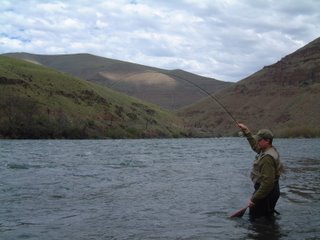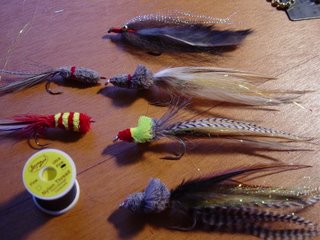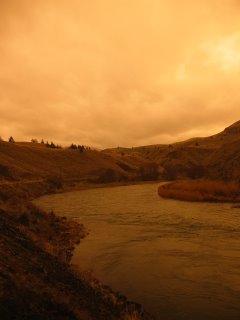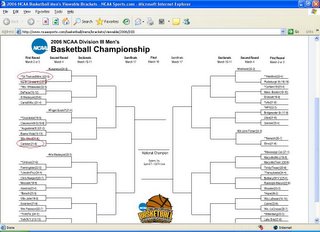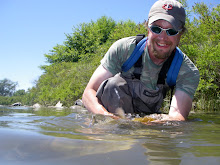Tuesday, March 28, 2006
Monday, March 27, 2006




 BLANK Creek
BLANK CreekMarch 25, 2006
Last Winter Outing—Great Day!
Conditions: air temp was around 30-35 F, sky was very cloudy—almost completely overcast. No wind at all. Midge activity all day: they
were approximately #16 midges, and they did not have the “furry” looking antennae that I often see on midges. They never really took to the
air—they just skittered around on the surface of the water. When at rest on the surface, they formed a sort of “T” with body and legs. I saw a
few large “clumps” of them floating downstream. They were dark/black in color—abdomen looked like it might have been slightly blue, but
hard to tell.
When I fished: 1000 to 1630—a long time, but fished very slowly and thoughtfully.
Where I fished: I parked at the BLANK bridge on BLANK and walked downstream for ~20-30 minutes. I stopped when I got
to a residence (BLANK) with a BLANK by the stream. I turned around there and started nymphing upstream.
What I fished: mostly nymphed with two flies—in many cases both were pink squirrels. However, I did use crane fly larvae as the lead fly
for a while, and I also used a small black bugger as the lead fly. Toward the end of the day I went away from the pink squirrel and used a
basic hares ear pattern. ALL of these flies were successful and effective. I also used a #16 soft hackle (close to a Wilted Spinach) to imitate
the hatching midges—I fished it at up and across at one hole and caught three beauties in three different ways: (1) I just lifted the rod because
it felt like a fish should be there, and one was there, (2) a fish splashed at the fly on the surface (or where I thought the fly should be—I
couldn’t really see it), (3) I saw the tip of my fly line jolt, so I set the hook. In all of these cases I think the pseudo-Spinach was a couple
inches below the surface. As for the nymphs—they seemed to like everything. At least one of the two biggest fish took the crane fly larva.
Where the fish were: in the deep blue pools mostly (had to nymph pretty deep in most
cases), but also in some moderately deep runs of broken water. Woody debris really
produced—logs running parallel to the flow usually housed fish. They were really
everywhere you’d expect them to be… pretty great!
Fish caught: an honest estimate of total brown trout landed is 12-15. Of those fish,
only one was a dinker. All others were a minimum 11-12”, with probably half going
14-15” and two big beautiful fish that may have pushed 16”. It was amazing—every
time I hooked a fish I felt the weight and saw the flash and I couldn’t believe it was
another big one…. Wow, was it fun. Most of the fish fought hard, so I had to use
the reel all day. Some took me downstream, some leapt once or twice…. One tailwalked
across the stream. I actually landed the majority of the fish I hooked, but I
lost a few too, and missed my share. Three interesting fish that I didn’t catch: (1) one
brute socked my indicator and gave me a heart attack (I think I did catch this fish
though a few casts later), (2) one nice fish snapped at and grabbed my nymph as I was
pulling it out to recast, (3) one great fish was hiding in this little tiny pocket by a log
and I hooked him but he shook the hook, then proceeded to leap into the air. In general,
there were few, but large fish; there were no holes that I found that were stacked
up with fish. Like BLANK—the population is BLANK…
However, unlike BLANK, almost every good hole here BLANK.
Keys to remember for next trip to this stream: (1) do not waste time fishing downstream
(I had tried swinging buggers here twice before and caught only one fish each
time) - hike way downstream and work back up, (2) key on woody debris—even if it
is in shallower water—but especially when near holes, and especially when logs run
parallel to flow, (3) two-nymph rig works really well, as usual, (4) next time bring dry
fly box, (5) be prepared for many stout fish!
I was so absorbed, and loving the stream and fish so much I didn’t eat a thing all day
and drank only a few mouthfuls of snow.
I’m glad that I finally tried (and stuck with to fruition) something other than
nymphing. Picking up the rod and feeling those fish that took the soft hackle was one
of my best fishing experiences… more rewarding that watching an indicator. Fishing
like that is more difficult, but also more interesting, involved and satisfying. I
bet if I bring a big attractor dry fly to this stretch in the summer it will provoke some
monster surface takes.
This was one of my top trout days of all time. I’ve never caught so many large,
strong fish. I feel very fortunate to have logged these hours and created these memories.
Friday, March 24, 2006
Tuesday, March 21, 2006

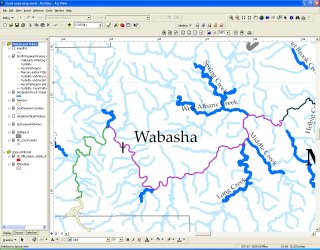
Folks are trying to repeal the Zumbro's catch and release regulation that has been installed for 12 miles of water below Lake Zumbro. A legislator has authored a bill that would remove the special regulation. Interestingly, the entire stretch in question is included on the draft 2006 impaired waters list, due to excessive mercury and/or PCB levels: fish maybe not safe to eat... A subsegment of the stretch is also listed for fecal pathogens: probably unsafe to wade in many cases. It should be noted that these listings indicate that there's enough data to document these problems, but they may or may not be much worse than surrounding waters that have yet to be examined. As depicted in this map, the green stretch is the proposed mercury/PCB listing and the red stretch is the proposed mercury/PCB and fecal pathogen listing. The black line indicates the approximate end of the 12 mile special regulation stretch (the start is the outfall of Lake Zumbro - seen here as a yellow polygon).
For discussion, go here: http://ontheflyguiding.proboards59.com/index.cgi?board=conservationenvironment&action=display&thread=1142609981
Friday, March 17, 2006
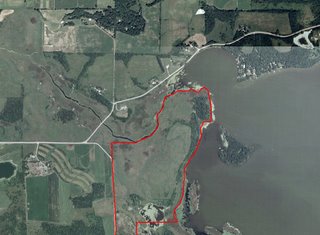
Approximate delineation of one segment of the Boyd Sartell Wildlife Management Area at Shields Lake. This is the very top of the Cannon River watershed - where the river's flow begins. The little nodule-bay in the NW corner is shallow and weedy, and receives water from the inlet you see cutting through the land... Thus, that area of the lake will probably warm first. That's an interesting piece of information.
Tuesday, March 14, 2006

 We were snowed in yesterday. School was closed and I was out sick, so we got to spend the entire day at home as a cozy little family unit. We probably got 8-9 inches, but north and east of us approx 18-23 inches fell... if you can believe that. The snow made for some beautiful scenes around the house. We focused on burning firewood, making cookies and watching a whole lotta birds descend in the backyard and eat the small apples leftover from last fall (mostly robins and cedar waxwings were present)... we wondered if they (the apples) had fermented. It was great to be at home... JD has recently become taken with birdwatching, so that was a highlight. He gets so excited when he sees dogs (and now birds too) that he literally squeaks with glee!
We were snowed in yesterday. School was closed and I was out sick, so we got to spend the entire day at home as a cozy little family unit. We probably got 8-9 inches, but north and east of us approx 18-23 inches fell... if you can believe that. The snow made for some beautiful scenes around the house. We focused on burning firewood, making cookies and watching a whole lotta birds descend in the backyard and eat the small apples leftover from last fall (mostly robins and cedar waxwings were present)... we wondered if they (the apples) had fermented. It was great to be at home... JD has recently become taken with birdwatching, so that was a highlight. He gets so excited when he sees dogs (and now birds too) that he literally squeaks with glee!



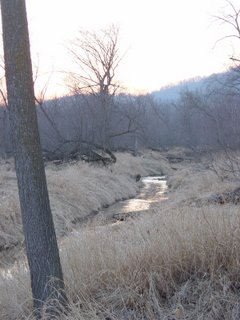 Winter fishing is some of the best... but the transition time can be tough. Waters are muddied right now, and that makes for more difficult fishing. These pictures were taken Friday, during a short scouting mission I completed between work's end and a late night meeting. A friend reports that he did get out on Friday, and while he had to fish many hours for them, he did hook two trout and land one, despite chocolate milk condition.
Winter fishing is some of the best... but the transition time can be tough. Waters are muddied right now, and that makes for more difficult fishing. These pictures were taken Friday, during a short scouting mission I completed between work's end and a late night meeting. A friend reports that he did get out on Friday, and while he had to fish many hours for them, he did hook two trout and land one, despite chocolate milk condition.


Thursday, March 09, 2006
Fishing's Worrisome Problem: Small Fry Aren't Biting
By Hugo Martin, Los Angeles TimesFebruary 22, 2006
LONG BEACH, Calif.
The bright yellow and gray fishing lines perform slow-motion shimmies in midair before whipping out onto a shallow pond in front of the clubhouse of the Long Beach Casting Club.
It’s early evening, and overhead stadium lights illuminate half a dozen middle-aged and elderly anglers practicing fly casts. The light gives the dancing lines a magical glow.
Former club president Jeff Sadler stands on the porch of the Craftsman-style clubhouse and points out the obvious: "The occupation of the average member is ‘retired.’"
Inside the clubhouse, where a fly-tying class is in session, the demographics aren’t much different. Seth Averill Murphy, 11, is the only youth among two dozen or so adults hunched over wooden tables, wrapping thread and feathers around insect-size hooks.
It’s also a common scene at lakes, streams and ponds. Fishing is losing its appeal to America’s youngsters. As a result, the sport is foundering, dropping in popularity behind bowling and working out at the gym.
Fishing once was a venerable pastime, passed on from father to son and grandfather to grandson. Today, desperate lake operators, fishing clubs and tackle manufacturers are funding youth fishing programs in a losing effort to reel in the next generation of anglers.
Blame the 70-hour workweek and the proliferation of two-income households, trends that cut into fishing time. Blame after-school activities and part-time jobs that keep youngsters away from the serene sport. And blame teens who are bored by the prospect of landing a bigmouth bass from a secluded lake cove or hooking a feisty brown trout from a rock-lined creek in the Eastern Sierra.
"What’s going on? You name it, it’s going on," said Mike Nussman, president of the American Sportfishing Association, a Virginia-based trade group that funds several programs for young anglers. "Look at the way people live their lives these days. There is tremendous competition for their time."
At the Long Beach pond, Sadler, a retired computer processor with salt-and-pepper hair, watches the graceful casts and recalls how his father and grandfather taught him to fly-fish in the lakes and streams near his boyhood home in Kansas.
But when Sadler became a father, he said, he couldn’t pass his love of fishing on to his son, who preferred fast-paced pursuits like water skiing and mountain biking.
"Fishing never came up high on his list," Sadler said.
President Hoover once described fishing as "the great occasion when we can return to the fine simplicity of our forefathers." Norman Rockwell memorialized fishing with paintings that depict a doting father, a fishing cap on his head and a pole in his hand, teaching his eager son to fish.
But after a boom in popularity in the four decades following World War II, sport fishing began to fall out of favor, according to surveys and fishing license sales.
A 2004 survey by the National Sporting Goods Association found that participation in fishing dropped 10 percent from 1994 to 2004 and was surpassed in popularity for the first time by camping, bowling and exercising with gym equipment.
In 1994, 45.7 million Americans said they fished at least once. That number dropped to 41.2 million in 2004, according to the survey. By comparison, 52.2 million Americans said they worked out with gym equipment in 2004 and 43.8 million bowled that year, the survey found.
Freshwater fishing, the sport in which most youngsters learn the basic skills, has suffered the steepest decline, while saltwater fishing has remained relatively stable. Fishing conditions ebb and flow each year, and industry officials say there is no proof that the sport’s decline is due to a lack of fish.
Some anglers secretly celebrate the sport’s decline, rejoicing in the smaller crowds they encounter at the best fishing spots. But fishing clubs and park rangers warn that the long-term effects on the sport could be devastating.
A drop in fishing license revenue and tackle sales means less funding for government-run habitat restoration programs and state hatcheries that stock lakes and streams. Sport fishing, a $116 billion industry, is also the economic engine that sustains many small towns in California’s Eastern Sierra.
The decline has varied from state to state. California, second only to Florida in generating retail sales and tax revenues from fishing, has had one of the steepest declines, with license sales dropping 15 percent from 1994 to 2004.
Fewer anglers also means fewer outdoor activists.
"People who fish care for their lakes and streams," said Bob Wiltshire of the Federation of Fly Fishers, a Montana-based nonprofit group. "We will lose that direct connection."
And then there are the social consequences of the decline. Surveys show that the top two reasons people fish are to have fun and to spend time with family and friends. Catching a fish is near the bottom of the list. Fishing, then, is a social event, a family bonding experience that is on the wane.
In hopes of drawing young people back, fishing groups, lake operators and park rangers are sponsoring free children’s fishing clinics and fishing gear loan programs, among other activities.
At Lake Casitas, 80 miles north of Los Angeles, lake manager Brian Roney and his staff try to entice youngsters each year with a Kids’ Fishing Day. The event includes a casting contest, fishing lessons, raffles and a free hot dog lunch.
Despite the declining numbers, most youngsters are not averse to picking up a rod and reel if given the chance, said Mark Damian Duda, executive director of Responsive Management, a Virginia-based survey research firm that has conducted studies on sport fishing’s decline. The problem, he said, is that parents and children have such busy schedules that few have time for fishing.
"A lot of kids want to fish and want to be with parents," he said. But "without Dad grabbing them and saying ‘Let’s go fishing,’ it’s not going to happen."
But Duda’s research also finds that a segment of youngsters — about 20 percent of those polled — say they don’t fish because they consider it a bore.
This attitude may explain why other outdoor activities, such as camping and hiking, continue to grow in popularity while fishing declines. Lake operators and club leaders wonder if fishing’s methodical pace is too slow for today’s multi-tasking youngsters.
Such a theory rings true to Jill Grigsby, a Pomona College sociology professor and expert on families and population trends.
"Today’s young people grew up with a lot of stimulation and seeing images that appear on the screen for only a couple of seconds, and that is not the way fishing works," she said. "Fishing requires a great deal of patience."
Inside the wood-paneled clubhouse at the Long Beach Casting Club, Seth Averill Murphy is the embodiment of hope for a sport that is aging out. The 11-year-old sits in the front row at the fly-tying class as a gray-haired man with bifocals shows how to tie copper-colored thread and peacock and pheasant feathers around tiny hooks. Seth’s tongue arches out of his mouth as he concentrates on his work in progress, a fly called a pheasant tail nymph.
His father, a high school art teacher from Los Angeles, is a longtime club member. But Seth said he asked his father to bring him to the class because he fell in love with fly fishing after a family vacation in Utah a couple of years ago. He was enthralled, he said, when he first duped a trout into striking a fly he had created by hand.
Seth is like many children his age. He plays soccer and swims at school. He has a PlayStation 2 at home and a GameBoy in his pocket. But he said no computer game compares with the thrill of catching a thrashing fish, its weight drawing in line and bending the pole.
"I have a friend who might like to try fishing," he said, looking up from his nearly completed fly. "I think I can teach him."
But when the fly-tying class resumed the next week, Seth was again the only youngster in the room.
By Hugo Martin, Los Angeles TimesFebruary 22, 2006
LONG BEACH, Calif.
The bright yellow and gray fishing lines perform slow-motion shimmies in midair before whipping out onto a shallow pond in front of the clubhouse of the Long Beach Casting Club.
It’s early evening, and overhead stadium lights illuminate half a dozen middle-aged and elderly anglers practicing fly casts. The light gives the dancing lines a magical glow.
Former club president Jeff Sadler stands on the porch of the Craftsman-style clubhouse and points out the obvious: "The occupation of the average member is ‘retired.’"
Inside the clubhouse, where a fly-tying class is in session, the demographics aren’t much different. Seth Averill Murphy, 11, is the only youth among two dozen or so adults hunched over wooden tables, wrapping thread and feathers around insect-size hooks.
It’s also a common scene at lakes, streams and ponds. Fishing is losing its appeal to America’s youngsters. As a result, the sport is foundering, dropping in popularity behind bowling and working out at the gym.
Fishing once was a venerable pastime, passed on from father to son and grandfather to grandson. Today, desperate lake operators, fishing clubs and tackle manufacturers are funding youth fishing programs in a losing effort to reel in the next generation of anglers.
Blame the 70-hour workweek and the proliferation of two-income households, trends that cut into fishing time. Blame after-school activities and part-time jobs that keep youngsters away from the serene sport. And blame teens who are bored by the prospect of landing a bigmouth bass from a secluded lake cove or hooking a feisty brown trout from a rock-lined creek in the Eastern Sierra.
"What’s going on? You name it, it’s going on," said Mike Nussman, president of the American Sportfishing Association, a Virginia-based trade group that funds several programs for young anglers. "Look at the way people live their lives these days. There is tremendous competition for their time."
At the Long Beach pond, Sadler, a retired computer processor with salt-and-pepper hair, watches the graceful casts and recalls how his father and grandfather taught him to fly-fish in the lakes and streams near his boyhood home in Kansas.
But when Sadler became a father, he said, he couldn’t pass his love of fishing on to his son, who preferred fast-paced pursuits like water skiing and mountain biking.
"Fishing never came up high on his list," Sadler said.
President Hoover once described fishing as "the great occasion when we can return to the fine simplicity of our forefathers." Norman Rockwell memorialized fishing with paintings that depict a doting father, a fishing cap on his head and a pole in his hand, teaching his eager son to fish.
But after a boom in popularity in the four decades following World War II, sport fishing began to fall out of favor, according to surveys and fishing license sales.
A 2004 survey by the National Sporting Goods Association found that participation in fishing dropped 10 percent from 1994 to 2004 and was surpassed in popularity for the first time by camping, bowling and exercising with gym equipment.
In 1994, 45.7 million Americans said they fished at least once. That number dropped to 41.2 million in 2004, according to the survey. By comparison, 52.2 million Americans said they worked out with gym equipment in 2004 and 43.8 million bowled that year, the survey found.
Freshwater fishing, the sport in which most youngsters learn the basic skills, has suffered the steepest decline, while saltwater fishing has remained relatively stable. Fishing conditions ebb and flow each year, and industry officials say there is no proof that the sport’s decline is due to a lack of fish.
Some anglers secretly celebrate the sport’s decline, rejoicing in the smaller crowds they encounter at the best fishing spots. But fishing clubs and park rangers warn that the long-term effects on the sport could be devastating.
A drop in fishing license revenue and tackle sales means less funding for government-run habitat restoration programs and state hatcheries that stock lakes and streams. Sport fishing, a $116 billion industry, is also the economic engine that sustains many small towns in California’s Eastern Sierra.
The decline has varied from state to state. California, second only to Florida in generating retail sales and tax revenues from fishing, has had one of the steepest declines, with license sales dropping 15 percent from 1994 to 2004.
Fewer anglers also means fewer outdoor activists.
"People who fish care for their lakes and streams," said Bob Wiltshire of the Federation of Fly Fishers, a Montana-based nonprofit group. "We will lose that direct connection."
And then there are the social consequences of the decline. Surveys show that the top two reasons people fish are to have fun and to spend time with family and friends. Catching a fish is near the bottom of the list. Fishing, then, is a social event, a family bonding experience that is on the wane.
In hopes of drawing young people back, fishing groups, lake operators and park rangers are sponsoring free children’s fishing clinics and fishing gear loan programs, among other activities.
At Lake Casitas, 80 miles north of Los Angeles, lake manager Brian Roney and his staff try to entice youngsters each year with a Kids’ Fishing Day. The event includes a casting contest, fishing lessons, raffles and a free hot dog lunch.
Despite the declining numbers, most youngsters are not averse to picking up a rod and reel if given the chance, said Mark Damian Duda, executive director of Responsive Management, a Virginia-based survey research firm that has conducted studies on sport fishing’s decline. The problem, he said, is that parents and children have such busy schedules that few have time for fishing.
"A lot of kids want to fish and want to be with parents," he said. But "without Dad grabbing them and saying ‘Let’s go fishing,’ it’s not going to happen."
But Duda’s research also finds that a segment of youngsters — about 20 percent of those polled — say they don’t fish because they consider it a bore.
This attitude may explain why other outdoor activities, such as camping and hiking, continue to grow in popularity while fishing declines. Lake operators and club leaders wonder if fishing’s methodical pace is too slow for today’s multi-tasking youngsters.
Such a theory rings true to Jill Grigsby, a Pomona College sociology professor and expert on families and population trends.
"Today’s young people grew up with a lot of stimulation and seeing images that appear on the screen for only a couple of seconds, and that is not the way fishing works," she said. "Fishing requires a great deal of patience."
Inside the wood-paneled clubhouse at the Long Beach Casting Club, Seth Averill Murphy is the embodiment of hope for a sport that is aging out. The 11-year-old sits in the front row at the fly-tying class as a gray-haired man with bifocals shows how to tie copper-colored thread and peacock and pheasant feathers around tiny hooks. Seth’s tongue arches out of his mouth as he concentrates on his work in progress, a fly called a pheasant tail nymph.
His father, a high school art teacher from Los Angeles, is a longtime club member. But Seth said he asked his father to bring him to the class because he fell in love with fly fishing after a family vacation in Utah a couple of years ago. He was enthralled, he said, when he first duped a trout into striking a fly he had created by hand.
Seth is like many children his age. He plays soccer and swims at school. He has a PlayStation 2 at home and a GameBoy in his pocket. But he said no computer game compares with the thrill of catching a thrashing fish, its weight drawing in line and bending the pole.
"I have a friend who might like to try fishing," he said, looking up from his nearly completed fly. "I think I can teach him."
But when the fly-tying class resumed the next week, Seth was again the only youngster in the room.
Tuesday, March 07, 2006
Field Notes: Trout Stream Updates–Southeastern Minnesota
from MN DNR Conservation Volunteer
Fisheries managers have an old saying: Good fishing begins on the land.
Larry Gates understands that well. As the DNR watershed coordinator for southeastern Minnesota, Gates has been working since the late 1970s to improve the health of the region's 151 trout streams. These coldwater homes to brown, brook, and rainbow trout are "crown jewels," he says.
But what Gates has witnessed during the past decade has him concerned about the future. "Sediment," he says. "I'm seeing much more of it in these trout streams, and that's alarming."
As farmers have converted pastures to row crops, runoff and streambank erosion have increased, Gates says. Thus more sediment enters the streams and covers the gravel runs and riffles that trout need to spawn.
Sediment also covers the aquatic invertebrates trout need to eat. Turbidity levels—a measure of sediment in a stream—exceed state standards for some trout streams, particularly in spring when runoff is heaviest.
"The bottom line is that we're seeing a shift from perennial cover types to more soybeans, which are highly, highly erodible," Gates says. "The change is being driven in large part by federal farm policy, which provides producers with financial incentives to plant certain row crops."
Research by Gyles Randall, a University of Minnesota soil scientist based in Waseca, illustrates the land-use transformation. Analyzing statistical data for a nine-county area in the southeast, Randall found that corn and soybeans occupied 64 percent of crop acreage in 1975 compared with 82 percent in 2001.
During the past two years, DNR fall stream surveys have shown trout populations are declining in some southeastern streams. "There has been a decline in smaller fish, less than 10 inches," says Jason Moeckel, DNR assistant regional fisheries manager in Rochester. "We've also had anglers tell us that they're seeing more sediment and aren't catching as many small fish."
Moeckel says sediment and trout don't mix. "At each life stage, trout are affected by sediment," he says. "Sediment can get in the gills of adult fish, stress them out, and ultimately kill them. Trout eggs can be smothered. The entire aquatic food chain can be disrupted from increased sediment loads."
According to Moeckel, DNR Fisheries plans to play a larger role in measuring sedimentation in southeastern streams, as well as restoring trout habitat such as Mill Creek near Chatfield. "The Mill Creek project was designed and constructed to be a prototype of future habitat improvement projects in the southeast," he says. "One of its key elements was creating a new floodplain to decrease stream power and water depth during periods of high runoff."
Both Moeckel and Gates emphasize that landowners have a critical role in determining healthy watersheds. "Most of the land in the southeast is privately owned," says Gates. "But keep in mind there are a number of conservation programs that landowners can enroll in to improve upland and riparian habitat."
After all, good fishing begins on the land.
For information on private-land conservation programs, contact your local farm service agency office or the DNR farmland wildlife coordinator at 651-259-5230.
Tori McCormick, freelance writer
from MN DNR Conservation Volunteer
Fisheries managers have an old saying: Good fishing begins on the land.
Larry Gates understands that well. As the DNR watershed coordinator for southeastern Minnesota, Gates has been working since the late 1970s to improve the health of the region's 151 trout streams. These coldwater homes to brown, brook, and rainbow trout are "crown jewels," he says.
But what Gates has witnessed during the past decade has him concerned about the future. "Sediment," he says. "I'm seeing much more of it in these trout streams, and that's alarming."
As farmers have converted pastures to row crops, runoff and streambank erosion have increased, Gates says. Thus more sediment enters the streams and covers the gravel runs and riffles that trout need to spawn.
Sediment also covers the aquatic invertebrates trout need to eat. Turbidity levels—a measure of sediment in a stream—exceed state standards for some trout streams, particularly in spring when runoff is heaviest.
"The bottom line is that we're seeing a shift from perennial cover types to more soybeans, which are highly, highly erodible," Gates says. "The change is being driven in large part by federal farm policy, which provides producers with financial incentives to plant certain row crops."
Research by Gyles Randall, a University of Minnesota soil scientist based in Waseca, illustrates the land-use transformation. Analyzing statistical data for a nine-county area in the southeast, Randall found that corn and soybeans occupied 64 percent of crop acreage in 1975 compared with 82 percent in 2001.
During the past two years, DNR fall stream surveys have shown trout populations are declining in some southeastern streams. "There has been a decline in smaller fish, less than 10 inches," says Jason Moeckel, DNR assistant regional fisheries manager in Rochester. "We've also had anglers tell us that they're seeing more sediment and aren't catching as many small fish."
Moeckel says sediment and trout don't mix. "At each life stage, trout are affected by sediment," he says. "Sediment can get in the gills of adult fish, stress them out, and ultimately kill them. Trout eggs can be smothered. The entire aquatic food chain can be disrupted from increased sediment loads."
According to Moeckel, DNR Fisheries plans to play a larger role in measuring sedimentation in southeastern streams, as well as restoring trout habitat such as Mill Creek near Chatfield. "The Mill Creek project was designed and constructed to be a prototype of future habitat improvement projects in the southeast," he says. "One of its key elements was creating a new floodplain to decrease stream power and water depth during periods of high runoff."
Both Moeckel and Gates emphasize that landowners have a critical role in determining healthy watersheds. "Most of the land in the southeast is privately owned," says Gates. "But keep in mind there are a number of conservation programs that landowners can enroll in to improve upland and riparian habitat."
After all, good fishing begins on the land.
For information on private-land conservation programs, contact your local farm service agency office or the DNR farmland wildlife coordinator at 651-259-5230.
Tori McCormick, freelance writer
Monday, March 06, 2006
JACK JOHNSON LYRICS
"Cookie Jar"
I would turn on the TV but it's so embarrasingTo see all the other people I don't know that they meanIt was magic at first when they spoke without soundAnd now this world is gonna hurt you better turn that thing downTurn it around
"It wasn't me", says the boy with the gun"Sure I pulled the trigger but it needed to be doneCause life's been killing me ever since it begunYou cant blame me cause I'm too young"
"You can't blame me sure the killer was my sonBut I didn't teach him to pull the trigger of the gunIt's the killer on this TV screenYou cant blame me its those images he seen
"Well "You can't blame me", says the media manWell "I wasn't the one who came up with the planI just point my camera at what the people want to seeMan it's a two way mirror and you cant blame me"
"You can't blame me", says the singer of the song Or the maker of the movie which he based his life on"It's only entertainment and as anyone can seeThe smoke machines and makeupHey you cant fool me"
It was you it was me it was every manWe've all got the blood on our handsWe only receive what we demandAnd if we want hell then hells what well have
And I would turn on the TVBut its so embarrasingTo see all the other peopleI don't even know that they meanAnd it was magic at firstBut it let everyone downAnd now this world is gonna hurtYou better turn it aroundTurn it around
"Cookie Jar"
I would turn on the TV but it's so embarrasingTo see all the other people I don't know that they meanIt was magic at first when they spoke without soundAnd now this world is gonna hurt you better turn that thing downTurn it around
"It wasn't me", says the boy with the gun"Sure I pulled the trigger but it needed to be doneCause life's been killing me ever since it begunYou cant blame me cause I'm too young"
"You can't blame me sure the killer was my sonBut I didn't teach him to pull the trigger of the gunIt's the killer on this TV screenYou cant blame me its those images he seen
"Well "You can't blame me", says the media manWell "I wasn't the one who came up with the planI just point my camera at what the people want to seeMan it's a two way mirror and you cant blame me"
"You can't blame me", says the singer of the song Or the maker of the movie which he based his life on"It's only entertainment and as anyone can seeThe smoke machines and makeupHey you cant fool me"
It was you it was me it was every manWe've all got the blood on our handsWe only receive what we demandAnd if we want hell then hells what well have
And I would turn on the TVBut its so embarrasingTo see all the other peopleI don't even know that they meanAnd it was magic at firstBut it let everyone downAnd now this world is gonna hurtYou better turn it aroundTurn it around
Technology, kids and the outdoors don't mix, so a choice must be made
by Tom Conroy, MN DNR
Darn near have the whole TV remote - DVD/VCR player thing figured out. Have even mastered the options on my cell phone. Yet I keep falling further and further behind in the dizzying world of technology. Henry David Thoreau once warned that the day is coming when we will become tools of our tools. Old Henry was pretty prophetic. That day arrived long ago. Now, the three worst words in the typical workplace are, "The computer's down." When the computer system crashes, employees are suddenly relegated to doing tasks that don't require a computer - mostly dusting their office furniture or re-arranging the pens and pencils in their desk drawer.The latest technological craze, apparently, is something called the Xbox. As I understand it, the Xbox console is a gizmo that allows a user to access somewhere in the neighborhood of three billion computer games, not one of which anyone over the age of 40 would have the slightest idea of how to play. Microsoft sold 450,000 Xbox 360 consoles on November 22, the first day they became available. Of course, by this time next year the 360 will be obsolete, to be replaced by the XXgeekbox, a device that will allow the average ten year-old to completely avoid reality for the next 25 years.Last year in this country alone, $8 billion was spent on video games. At the rate we're going, the limbs of our young people are going to start to atrophy to the point where someday only the push button fingers will work. Mother Nature, it seems, is losing the battle with technology for the hearts and minds of the young. Rather than race home after school to join dad for a couple hours of pheasant hunting, many of the younger crowd races home to the computer. Rather than trade stories with friends about their latest outdoor adventure, they talk (in code) to complete strangers over the Internet.We live in a world of information overload. It comes from so many sources, so quickly, that it's like trying to drink water from a fire hydrant. If it isn't fast-paced and glitzy, many kids lose interest. There are no such guarantees with nature. Its' flow and rhythms can be slow, measured, even droning. On the other hand, it can suddenly become furious, brilliant, awesome. You take, with patience, what nature gives. She won't be changed by the click of a mouse or remote control and that, in the minds of many, can be a turn-off. Patience is no longer considered quite the virtue it once was, it seems.Growing up in a small southern Minnesota town along the Minnesota River provided splendid opportunities for exploring the outdoors. A bike ride of just a few blocks took us from the tame life of town to the wild side of the country. There we might build a fort of tree branches, follow a killdeer feigning injury, float a homemade raft across a backwater pond, cast heavy braided line into the river, or hike deer trails up and down ravines. Contrast those youthful experiences to present day, when a walk through a city park can be considered a wilderness experience. So, as young people become less inclined to immerse themselves in the outdoors, where will the future advocates for natural resource conservation come from? Studies have shown that environmental attitudes are formed as a result of life experiences rather than any specific program designed to change attitudes. A great deal of these life experiences are learned during childhood, such as hunting, hiking, fishing, or camping. And parents are the principle introducers of young people to the outdoors.When young people are introduced to the sights, sounds, smells and tastes of the outdoors, they gain awareness of natural resources. Awareness leads to appreciation, appreciation leads to emotional attachment, and emotional attachment leads to action. In the end, we conserve only what we love and appreciate.Years ago famed conservationist Aldo Leopold opined the following. "A man may not care for golf and still be human, but the man who does not like to see, hunt, photograph or otherwise outwit birds or animals is hardly normal. He is supercivilized and I for one do not know how to deal with him. Babes do not tremble when shown a golf ball, but I should not like to own the boy whose hair does not lift his hat when he sees his first deer. ?When the last corner lot is covered with tenements we can still make a playground by tearing them down, but when the last antelope goes by the board, not all the playground associations in Christendom can do aught to replace the lost." As adults, the choice is ours. Another video game or a walk in the woods.
by Tom Conroy, MN DNR
Darn near have the whole TV remote - DVD/VCR player thing figured out. Have even mastered the options on my cell phone. Yet I keep falling further and further behind in the dizzying world of technology. Henry David Thoreau once warned that the day is coming when we will become tools of our tools. Old Henry was pretty prophetic. That day arrived long ago. Now, the three worst words in the typical workplace are, "The computer's down." When the computer system crashes, employees are suddenly relegated to doing tasks that don't require a computer - mostly dusting their office furniture or re-arranging the pens and pencils in their desk drawer.The latest technological craze, apparently, is something called the Xbox. As I understand it, the Xbox console is a gizmo that allows a user to access somewhere in the neighborhood of three billion computer games, not one of which anyone over the age of 40 would have the slightest idea of how to play. Microsoft sold 450,000 Xbox 360 consoles on November 22, the first day they became available. Of course, by this time next year the 360 will be obsolete, to be replaced by the XXgeekbox, a device that will allow the average ten year-old to completely avoid reality for the next 25 years.Last year in this country alone, $8 billion was spent on video games. At the rate we're going, the limbs of our young people are going to start to atrophy to the point where someday only the push button fingers will work. Mother Nature, it seems, is losing the battle with technology for the hearts and minds of the young. Rather than race home after school to join dad for a couple hours of pheasant hunting, many of the younger crowd races home to the computer. Rather than trade stories with friends about their latest outdoor adventure, they talk (in code) to complete strangers over the Internet.We live in a world of information overload. It comes from so many sources, so quickly, that it's like trying to drink water from a fire hydrant. If it isn't fast-paced and glitzy, many kids lose interest. There are no such guarantees with nature. Its' flow and rhythms can be slow, measured, even droning. On the other hand, it can suddenly become furious, brilliant, awesome. You take, with patience, what nature gives. She won't be changed by the click of a mouse or remote control and that, in the minds of many, can be a turn-off. Patience is no longer considered quite the virtue it once was, it seems.Growing up in a small southern Minnesota town along the Minnesota River provided splendid opportunities for exploring the outdoors. A bike ride of just a few blocks took us from the tame life of town to the wild side of the country. There we might build a fort of tree branches, follow a killdeer feigning injury, float a homemade raft across a backwater pond, cast heavy braided line into the river, or hike deer trails up and down ravines. Contrast those youthful experiences to present day, when a walk through a city park can be considered a wilderness experience. So, as young people become less inclined to immerse themselves in the outdoors, where will the future advocates for natural resource conservation come from? Studies have shown that environmental attitudes are formed as a result of life experiences rather than any specific program designed to change attitudes. A great deal of these life experiences are learned during childhood, such as hunting, hiking, fishing, or camping. And parents are the principle introducers of young people to the outdoors.When young people are introduced to the sights, sounds, smells and tastes of the outdoors, they gain awareness of natural resources. Awareness leads to appreciation, appreciation leads to emotional attachment, and emotional attachment leads to action. In the end, we conserve only what we love and appreciate.Years ago famed conservationist Aldo Leopold opined the following. "A man may not care for golf and still be human, but the man who does not like to see, hunt, photograph or otherwise outwit birds or animals is hardly normal. He is supercivilized and I for one do not know how to deal with him. Babes do not tremble when shown a golf ball, but I should not like to own the boy whose hair does not lift his hat when he sees his first deer. ?When the last corner lot is covered with tenements we can still make a playground by tearing them down, but when the last antelope goes by the board, not all the playground associations in Christendom can do aught to replace the lost." As adults, the choice is ours. Another video game or a walk in the woods.
 Got out fishing yesterday, despite ominous weather report. When I pulled up to the stream, it had been snowing, with flake size and downfall intensity increasing... Good time to try out my impervious winter jacket: it did hold up very well - kept me warm and dry. The fishing was perfect - I had the entire stream to myself. Snow just pouring down... every time I'd move after standing blue-heron-still for a while I'd slough off big chunks of accumulated wet snow. The fish were everywhere they're supposed to be - got 8-9 from one hole and 12 overall from 10-12 PM. Every sight I took in seemed worthy of a photograph. I really wanted to stay out there for the entire day. However, the rate of accumulation started to get a little scary, so when I broke off my flies at noon, I walked back to the car... thinking I might drive to another section of the stream. However, the car would not move from its parking spot. Every time I tried, I just slipped further into the ditch.... No panic - couldn't think of a better place to be stranded, and I wasn't expected home for hours. So I just kept trying - digging, spinning, digging, looking... Finally a local couple came and we pushed the car onto the road. The drive home was a white-knuckler... I aborted the remains of the fishing day, thinking the longer I stayed out the tougher it'd be to get back to home base. It all turned out well. No big fish, but plenty of great action, and a fantastic, memorable day on the water.
Got out fishing yesterday, despite ominous weather report. When I pulled up to the stream, it had been snowing, with flake size and downfall intensity increasing... Good time to try out my impervious winter jacket: it did hold up very well - kept me warm and dry. The fishing was perfect - I had the entire stream to myself. Snow just pouring down... every time I'd move after standing blue-heron-still for a while I'd slough off big chunks of accumulated wet snow. The fish were everywhere they're supposed to be - got 8-9 from one hole and 12 overall from 10-12 PM. Every sight I took in seemed worthy of a photograph. I really wanted to stay out there for the entire day. However, the rate of accumulation started to get a little scary, so when I broke off my flies at noon, I walked back to the car... thinking I might drive to another section of the stream. However, the car would not move from its parking spot. Every time I tried, I just slipped further into the ditch.... No panic - couldn't think of a better place to be stranded, and I wasn't expected home for hours. So I just kept trying - digging, spinning, digging, looking... Finally a local couple came and we pushed the car onto the road. The drive home was a white-knuckler... I aborted the remains of the fishing day, thinking the longer I stayed out the tougher it'd be to get back to home base. It all turned out well. No big fish, but plenty of great action, and a fantastic, memorable day on the water.


 The Adams Dominator
The Adams DominatorI don't have any fine dubbing for dry flies, because until now I haven't really tied them much. I sometimes use just the working thread for the body... but I decided to try this over the weekend. I think the deer hair body looks buggy and will help the fly float higher... absorb less water than dubbing. I'll have to see I guess - sometime this spring. I like the look of this fly.



Friday, March 03, 2006

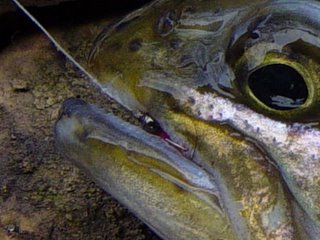


Another beautiful rainbow... This one came from a pretty small pool, and fought really hard - tried to run downstream. I believe they fight harder than browns... they are chunky and deep. Add another to the list that's been pricked by the PS. Also caught a couple nice brown trout this day... you can see one of them here demonstrating they physics of fish movement as he heads back to the depths.

